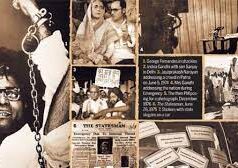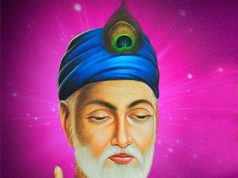
Swami Shraddhanand alias LalaMunshiramVij was born on 22 February 1856in the village of Talwan in the Jalandhar District of the Punjab Province of India. He was the youngest child in the family of Lala Nanak Chand, who was a Police Inspector in the United Provinces (now Uttar Pradesh) under the rule of British East India Comapany.He was a great Indian education advocate and an Arya Samaj missionary who propagated the teachings of Swami DayanandaSaraswati. His pioneer works included the establishment of educational institutions, like the GurukulKangri University, and played a key role on the Sangathan (consolidation) of Sanatan Hindu Dharma and the Shuddhi (re-conversion), a Hindu reform movement in the 1920s.
-
- “It is a notorious fact that many prominent Hindus who had offended the religious susceptibilities of the Muslims either by their writings or by their part in the Shudhi movement have been murdered by some fanatic Musalmans. First to suffer was Swami Shradhanand, who was shot by Abdul Rashid on 23rd December 1926 when he was lying in his sick bed.”-B.R. Ambedkar, Pakistan or The Partition of India (1946)
-
- “The Arya Samaj was the first Hindu movement to take up a bold stand in this context. MaharshiDayanand himself had showed up Muhammad for the sort of man he was. Soon after, however, the Arya Samaj was silenced effectively by a series of murders, notably that of PanditLekhram and Swami Shraddhananda. The British were inclined to permit fair criticism, particularly that which was based on Islamic sources. But they could not prevent Muslim assassins from taking the law in their own hands.”-Goel, Sita Ram (editor) (1998). Freedom of expression: Secular theocracy versus liberal democracy. Ch. 6
-
- “A new type of wisdom, though within the four walls of Islamic fanaticism and day-dreaming, dawned upon KhwajaHasanNizami in the early years of the 20th century. He was no ordinary pen-pusher or paid mullah in some suburban mosque. On the contrary, he was a highly placed ‘divine’ in the hierarchy of NizamuddinAuliya’s prestigious silsilã, and widely honoured in the Muslim world. He published in 1920 a big book, FãtamiDãwat-i-Islam, in which he advocated all means, fair and foul, by which Hindus were to be converted to Islam. He advised the mullahs to concentrate on Hindu ‘untouchables’, and convert them en masse so that Muslims could achieve parity of population with the Hindus. He disclosed in the introduction to his book that he had consulted many Muslim leaders including the Agha Khan regarding the soundness of his scheme, and that all of them had agreed with the caution that the scheme should be kept a closely guarded secret. Unfortunately for the Khwaja, the scheme came to the notice of Swami Shraddhananda who exposed it, fought it tooth and nail, and frustrated it completely by means of his Shuddhi Movement.”-Goel, Sita Ram (1995). Muslim separatism: Causes and consequences.
-
- “The book Hindu Sangathan, Saviour of the Dying Race (1926) by Swami Shraddhananda… was a true milestone in the development of Hindu revivalism.”- Elst, Koenraad (2014). Decolonizing the Hindu mind: Ideological development of Hindu revivalism. New Delhi: Rupa. p. 375
-
- “The reason why Swami Shraddhananda is rarely given due attention in studies of Hindu nationalism is that by his courageous commitment to reform and equality, this pioneer contradicted the negative stereotype so starkly that our experts prefer to keep him out of view.”-Elst, K. (2010). The saffron swastika: The notion of “Hindu fascism”. I.272
- “The first great achievement of the TablighiJamaat was the cold-blooded murder of Swami Shraddhananda. The swami had been lionized by Muslims when he supported the Khilafat agitation during the first Non-Cooperation movement (1921-22). “But as he was closely associated with the šuddhi movement… a section of Muslims cherished bitter hatred against him. On 23 December 1926, when the Swami after a serious attack of pneumonia was lying in his bed, a Muslim entered into his room on false pretext and stabbed him with a dagger.”
- R. C. Majumdar (ed.), The History And Culture of the Indian People, Volume XI, Struggle For Freedom, Second Edition, Bombay, 1978, pp. 435-36. Quoted in: Sita Ram Goel: Time for Stock Tacking, App. 1
- “The same Abdul Bari spoke in a different tone in September 1923. Professor Francis Robinson reports: “Abdul Bari, the erstwhile apostle of Hindu-Muslim unity, came to the fore again. Now he spoke the language of the zealot. He urged the Muslims to sacrifice cows without regard to Hindu feelings, and declared: ‘If the commandments of the Shariat are to be trampled under foot then it will be the same to us whether the decision is arrived on the plains of Delhi or on the hilltops of Simla. We are determined to non-cooperate with every enemy of Islam, be he in Anatolia or Arabia or at Agra or Benares.” The immediate provocation for Abdul Bari’s outburst was the Shuddhi Movement started by Swami Shraddhananda in the summer of 1923. Swamiji in turn had been led to pursue this path in response to a book, FãtimîDãwat-i-Islãm, by HasanNizami… Swamiji had written a pamphlet, The Hour of Danger, in which he had warned Hindu society to be on its guard against mischievous Muslim machinations. According to his biographer, J.T.F. Jordens, “In his pamphlet the Swami went on to show how Nizami in his own introduction referred to his consultations with many Muslim leaders, including the Agha Khan, and how all had agreed that the publication of his work should remain a carefully kept secret, within the Muslim community. The single purpose of the pamphlet was to describe all the means, fair and foul, by which Hindus could be induced to become Muslims…. The Swami felt that he had uncovered a giant conspiracy. His pamphlet consisted practically entirely of quotations from Nizami’s work, showing how all Muslims should be involved in the fight for the spread of Islam: how pirs, fakirs, politicians, peasants, zamindars, hakims, etc. could be used and what their allotted task should be. It also stressed the need for secrecy and for an extensive spy network.’
Abdul Bari should have denounced HasanNizami who had hatched a plot against the Hindus without any provocation whatsoever on the part of the latter. But the self-righteous Mullah and the authoritative interpreter of the Shariat, had done just the opposite. He had joined his voice with that of the other Mullahs in egging upon a Muslim fanatic to murder Swami Shraddhananda. The Mullahs of Deoband had offered special prayers for the soul of the assassin.”-Sita Ram Goel, Muslim Separitism – Causes and Consequences with reference to J.T.F. Jordens, Swami Shradhananda: His Life and Causes, New Delhi, 1981, and Francis Robinson, Separatism Among Indian Muslims, Delhi, 1975
-
- “The Urdu pamphlet DaîIslâm by KhwajaHasanNizami came into his hands. He immediately wrote in answer a pamphlet, the title of which clearly expressed his violent reaction: ‘The Hour of Danger: Hindus, be on your guard! The order has been given to attack and destroy the fortress of your religion in the hidden dead of night!’ (…) The Swami found out that the pamphlet was in fact only the introduction to a larger volume called FâtamîDawat-i-Islâm, which had been published as early as 1920, years before the shuddhi of the Malkanas started. In this the Swami saw proof that the Muslim reaction of the day was not merely against the shuddhi and sangathan movements, but rather was part of a sinister plot hatched years earlier. In his pamphlet the Swami went on to show how Nizami in his own introduction referred to his consultations with many Muslim leaders, including the Aga Khan, and how all had agreed that the publication of his work should remain a carefully kept secret within the Muslim community. The single purpose of the pamphlet was to describe all the means, fair and foul, by which Hindus could be induced to become Muslims. (…) In the conclusion of his own booklet, the Swami suggested some ways in which the Muslim threat could be countered. The openness and ethics of his methods stood in strong contrast with Nizami’s tactics.” -Prof. J.T.F. Jordens, “Swami Shraddhananda, His Life and Causes” (OUP, Delhi 1981). (p.140-141)DEC 23 Swami Shraddhanand Balidan diwas…














